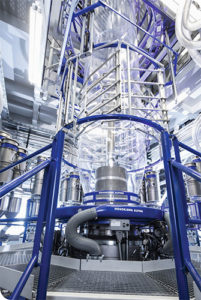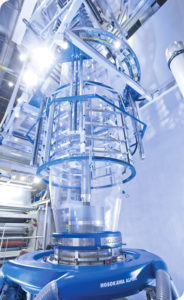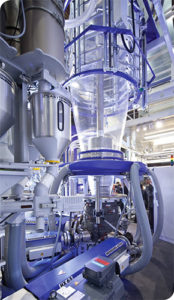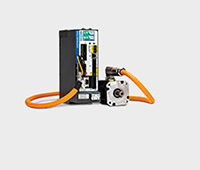When a multi-national blown film company sought to gain trackable improvements at its plant, they needed a key upgrade: an extrusion system with more flexible temperature control zones, real-time monitoring and adjustment of all machine conditions, and greater ease of use for system operators.
The company looked to Massachusetts-based Hosokawa Alpine American. Alpine, a supplier of blown film extrusion systems to the North American plastics industry, felt they had just the right equipment for the job. The Alpine design team had a “light bulb” moment, says Alpine’s VP of Engineering Jay Ragusa . “We quickly realized our new 9-Layer X-Die line system would give the company a complete zone temperature control system and remote I/O, plus the necessary hardware and touchscreen HMI to give their operators an entirely new approach to in-process control and product quality monitoring.”
Ragusa also explained that this was an opportunity to help a client with a new system even more advanced than their previous offerings. “We had a very successful machine design from the 1990’s and it had performed extremely well, but we saw dramatic improvements in new controls and data transmission technology from our partner Siemens and their local distributor, Dittman & Greer, a specialist in electric temperature systems and machine controls.” Among these advances, Ragusa notes, were the new zone temperature control system, as well as the Box PC with full automation and visualization software onboard running with WinCC.
Prior to making its final choice, Alpine’s client did its due diligence, calling in various competitors for the business. Thorough testing in the lab pilot plant was conducted, with strong emphasis on component failure analysis, system fault detection and the robust qualities of the competing systems for 24/7 use in the harsh environment of the blown film industry.
After the testing and evaluation process in-house, the decision was made to move forward with Alpine, comprising a new zone temperature control, Profinet communication platform, motors, drives, PLC and touchscreen HMI.
This new machine included up to 120 separate temperature control zones. Typical systems allow for a 2-3ºF variation in zone temperatures; with the new system that variation is reduced to less than 1ºF.
Ragusa also details other system improvements designed into the new machine. “The new industrial flat panel on the PC has a wider screen for easy viewability. Plus, our older system, while modular, had little remote I/O. The auto-tune function, combined with the better CPU in the PLC, gives us a much stronger package of internal software in combination with hardware. Since we were making the transition within a Siemens protocol, no significant software conversion was required and all data feeds continue on Profinet.”
Overall data transmission has also improved, as the communication speeds are faster, plus the open architecture of the system can convey all data to the other departments seamlessly.
Additionally, the Siemens system includes the plug-and-play remote I/O hardware and the open architecture of the control system. The quick- connect, plug-and-play remote I/O hardware reduces installation, commissioning and replacement time of the system hardware. The open architecture of the control system allows end-user adjustment of control parameters to suit each specific application and stores thousands of recipe data points. The Alpine team routinely customizes the front end of the controller HMI for easier customer training and a seamless transition from legacy systems for operators in use.
On the maintenance side, a customer can quickly determine component faults and either take corrective action or order a new component from the onboard controller.
Hosokawa Alpine American
www.halpine.com
Filed Under: Displays • HMIs • operator interfaces • monitors, MOTION CONTROL, PLCs + PACs








Tell Us What You Think!